11.10.2022
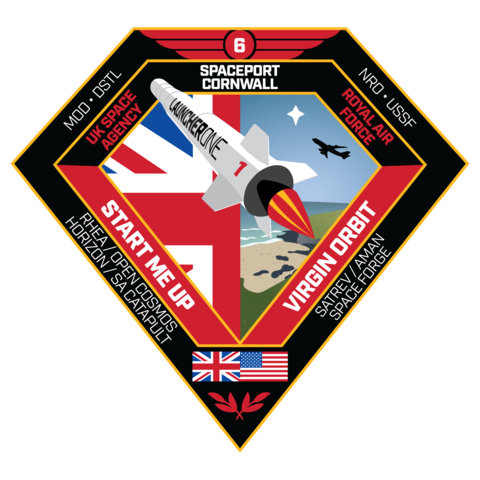
Manifest complete, flight hardware departs California for the first orbital launch from U.K. soil
LONG BEACH, Calif.--(BUSINESS WIRE)-- The countdown to Cornwall has begun as Virgin Orbit (Nasdaq: VORB) readies for Start Me Up, the newly-titled forthcoming historic launch from the United Kingdom. The launch provider’s carrier aircraft, ground support equipment (GSE), and rocket will depart this week from California following the first round of now complete wet dress rehearsals. On track for a November launch, Start Me Up is led by a joint mission between the U.S. and U.K. governments, launched by Virgin Orbit, the United Kingdom Space Agency (UKSA), UK Space Command, and Spaceport Cornwall.
Start Me Up will be a launch of many firsts: the first orbital launch ever from the United Kingdom; the first international launch for Virgin Orbit, and the first commercial launch from Western Europe. The first of the company’s hardware will begin its transport to Cornwall, U.K. on Sunday October 9th, due to arrive at Spaceport Cornwall on Tuesday October 11th with the GSE and rocket quickly following later in the week.
Dan Hart, CEO of Virgin Orbit, said: “What an incredible honor it is for us to be part of something as monumental as bringing Britain into the business of launch. Working with our partners across the UK government, we’re starting up a new capability that will serve the people, the economy, and the security of the UK.”
U.K. Minister of Science Nusrat Ghani said: “As we move ever closer to the first satellite launch from U.K. soil, it’s excellent to see the progress being made by Virgin Orbit, Spaceport Cornwall and those across government in delivering this historic mission, the first of its kind in Europe.
“With 47,000 jobs across the U.K., our growing space industry is a vital part of the economy and has an important role to play in catalysing investment, generating growth and prosperity. I’m looking forward to working with this innovative sector and delivering on our National Space Strategy.”
Ian Annett, Deputy CEO at the U.K. Space Agency, said: “Seeing Virgin Orbit’s aircraft take off is an exciting reminder that we are close to the first launch from U.K. soil and first launch of a satellite from Europe. This will be an iconic moment in the history of U.K. space endeavours, so it is fitting that the mission has been named after a song from the Rolling Stones, one of the U.K.’s most iconic bands.”
Air Vice-Marshal Paul Godfrey (Commander, U.K. Space Command), commented: “The completion of the fuelling and pressurisation dress rehearsals in the USA, and the announcement of the mission name and manifest, has started countdown to launch from the U.K. I’ve seen first-hand the hard work and collaboration that has gone into making this happen, and we can now look forward to Virgin Orbit’s arrival in Cornwall. The very first space launch, carrying government and industry satellite payloads, marks Start Me Up as a historic moment for the United Kingdom.
“Developing new launch capabilities will build on the strengths of our space sector and attract companies from around the world to benefit from these commercial opportunities. This will catalyze investment, bring new jobs to communities and organisations right across the U.K., as well as inspiring the next generation of space scientists and engineers.”
Melissa Thorpe, Head of Spaceport Cornwall: “It’s time to Start Us Up! This is a huge moment for us all in Cornwall as the journey to U.K. space launch has officially begun. The mission name and patch reflect and embrace the incredible partnerships between our two countries and teams.”
This will be the fifth consecutive Virgin Orbit launch to carry payloads for both private companies and governmental agencies. The flight manifest, now completely full, includes payloads from seven global customers, a testament to the flexibility and possibilities offered through responsive launch solutions.
The launch service was acquired by the National Reconnaissance Office (NRO) from Virgin Orbit National Systems, a Virgin Orbit U.S. subsidiary serving classified customers, as the first task order on NRO’s Streamlined Launch Indefinite Delivery, Indefinite Quantity Contract or “SLIC.” Start Me Upmanifest includes:
- IOD-3 AMBER (aka IOD-3) – Developed by Satellite Applications Catapult (“SA Catapult”) and Horizon Technologies and built by AAC Clyde Space, all based in the U.K. IOD-3 Amber is expected to be the first of more than 20 Amber satellites to provide space-based Maritime Domain Awareness (MDA) data to users.
- Prometheus-2 – Two cubesats owned by the U.K. Ministry of Defense’s (MOD) Defense Science & Technology Laboratory Dstl. These satellites, co-funded with Airbus Defence and Space who are designing them jointly with In-Space Missions, will support MOD science and technology (S&T) activities both in orbit and on the ground through the development of ground systems focused at Dstl’s site near Portsmouth.
- CIRCE (Coordinated Ionospheric Reconstruction CubeSat Experiment) – CIRCE is part of a joint mission between the U.K.’s Defense Science and Technology Laboratory and the U.S. Naval Research Laboratory (NRL).
- DOVER – Developed by RHEA Group in the UK, it is the company’s first satellite in its 30-year history. The satellite is being co-funded through the European Space Agency’s (ESA) Navigation Program (NAVISP) and built by Open Cosmos of the United Kingdom. DOVER is a SmallSat that was created as a pathfinder for resilient global navigation satellite systems.
- ForgeStar-0 – Developed by Space Forge of Wales, the satellite is a fully returnable and reusable platform to enable in-space manufacturing. This launch will be the first for the company’s ForgeStar platform and will test future returns from space technology.
- AMAN – Oman’s first orbital mission, it is a single earth observation satellite meant to demonstrate the future feasibility of a larger constellation and was developed after a memorandum of understanding among the Sultanate of Oman, Polish Small Satellite manufacturer and operator SatRev, Poland-originated AI data analytics specialists TUATARA, and Omani-based merging technology innovator ETCO. The agreement includes additional planned small satellites, including this, the first in Oman’s history.
- STORK-6 – STORK-6 is the next installment of Polish Small Satellite manufacturer and operator SatRev’s STORK constellation. Virgin Orbit previously launched two spacecraft in this constellation on a previous launch and looks forward to continuing to launch SatRev’s STORK spacecraft in the future.
The missions of these satellites span a wide range of activities aimed at improving life on planet Earth, including reducing the environmental impact of production; preventing illegal trafficking, smuggling, and terrorism; and a host of national security functions.
Virgin Orbit has been working closely with the United Kingdom’s Civil Aviation Authority (CAA), the Royal Air Force (RAF), and the Spaceport Cornwall team to make all necessary preparations for liftoff.
Start Me Up is so named as a tribute to one of the most iconic British rock and roll bands of all time, the Rolling Stones. The hit song debuted on the 1981 album Tattoo You and was later released on the Forty Licks compilation by Virgin Records in 2002.
About Virgin Orbit
Virgin Orbit (Nasdaq: VORB) operates one of the most flexible and responsive space launch systems ever built. Founded by Sir Richard Branson in 2017, the Company began commercial service in 2021, and has already delivered commercial, civil, national security, and international satellites into orbit. Virgin Orbit’s LauncherOne rockets are designed and manufactured in Long Beach, California, and are air-launched from a modified 747-400 carrier aircraft that allows Virgin Orbit to operate from locations all over the world in order to best serve each customer’s needs. Learn more at www.virginorbit.com and visit us on LinkedIn, on Twitter @virginorbit, and on Instagram @virgin.orbit.
Quelle: Virgin Orbit
----
Update: 13.10.2022
.
Virgin jumbo arrives in Cornwall for UK space launch
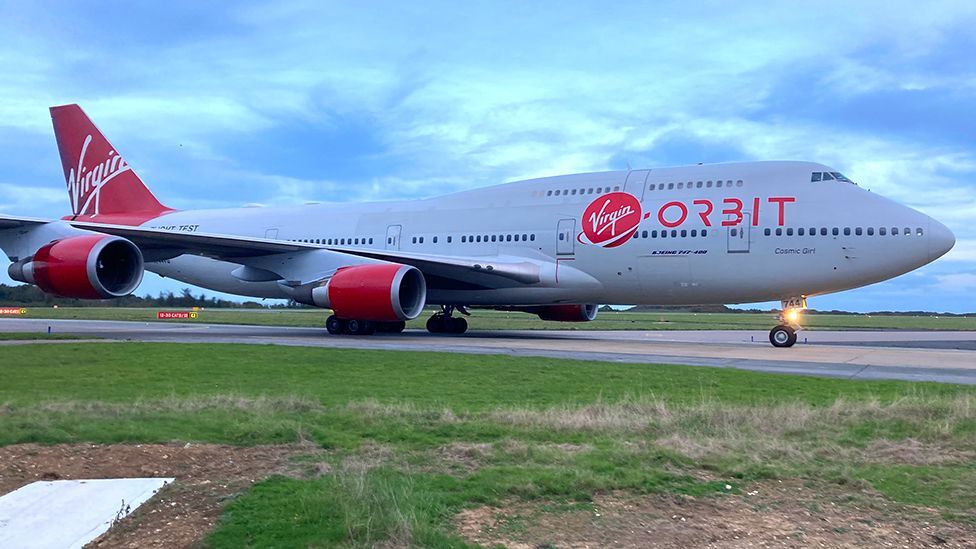
Cosmic Girl touched down at Spaceport Cornwall just as the Sun was going down over the Atlantic
The aeroplane that will be used for the first-ever satellite launch from the UK has touched down to begin mission preparations.
The 747 is set to despatch a rocket out over the Atlantic next month to put nine spacecraft, including British-built ones, high above Earth.
Virgin Orbit's jumbo, known as Cosmic Girl, landed at Newquay Airport in Cornwall just before 18:30 BST.
It will now take part in a series of rehearsals leading up to launch day.
Squadron Leader Mathew "Stanny" Stannard came in with the aircraft. The RAF man will pilot the 747 on its historic mission.
"It feels amazing to be here now. It feels amazing to be home, amazing to bring Cosmic Girl in here. And we're weeks away now from the first launch from the UK. So, it's very real. I'm really excited," he told BBC News.
When precisely the launch will occur is a little uncertain. Permission must come from the Civil Aviation Authority, and it has yet to issue the necessary licences. But the CAA is expected to give the "green light" any day now.
Cosmic Girl is a former Virgin Atlantic passenger plane. Its home base is in the US, in California, where it runs missions out over the Pacific.
But Virgin Orbit's founder, the UK entrepreneur Sir Richard Branson, wants to expand the company's satellite launch business worldwide, starting in the country of his birth.
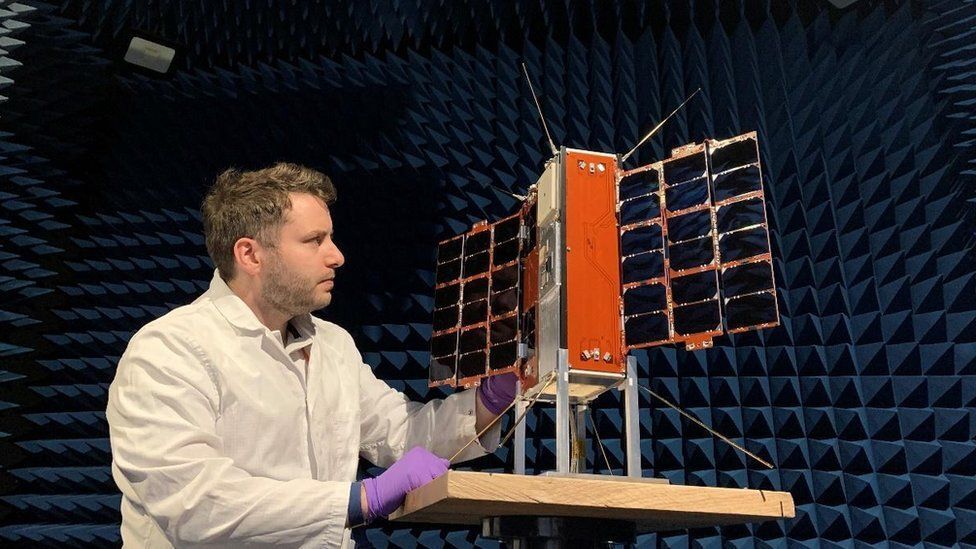
A Prometheus satellite, built by the In-Space company, undergoes testing
Cosmic Girl has been adapted to carry a rocket, called LauncherOne, to an altitude of about 35,000ft (10km), where it drops the liquid-fuelled booster into a freefall.
Roughly four seconds into that fall, as the jumbo banks hard to the right, LauncherOne ignites its engine to begin the climb to orbit.
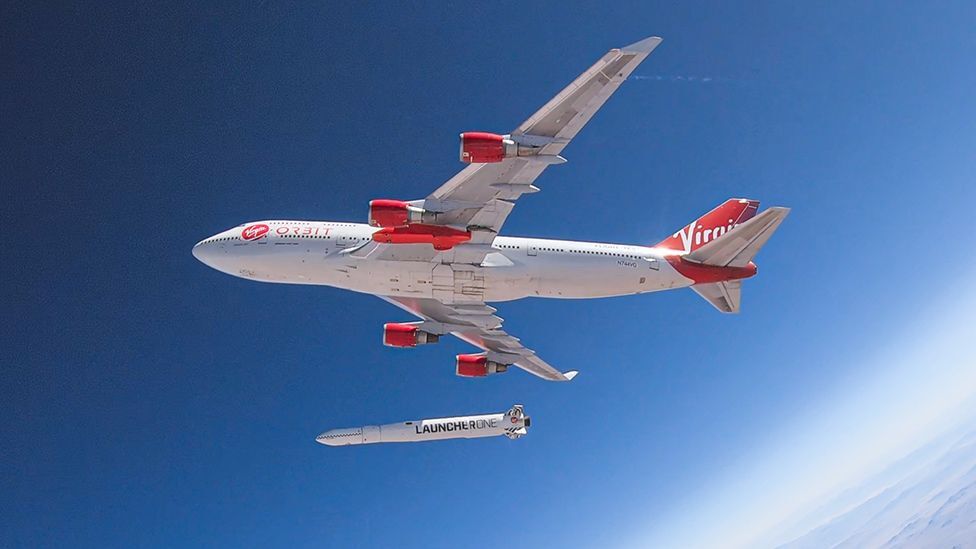
Cosmic Girl launches the rocket from under its left wing at 35,000ft
The first UK launch mission, dubbed appropriately "Start Me Up", will be lofting nine individual small satellites for seven projects.
AMBER IOD-3 is a fully UK-developed spacecraft designed to monitor what's happening on the ocean. It's envisaged to be the first satellite in a 20-strong constellation to collect maritime intelligence.
Prometheus-2 is a pair of small satellites, or cubesats, owned by the UK's defence research agency, the Defence Science & Technology Laboratory (DSTL). They'll test new approaches to imaging and the monitoring of radio signals
CIRCE is two cubesats for DSTL and the US Naval Research Laboratory. Their "space weather" instrumentation will monitor the disturbances above the Earth that arise from interactions with the Sun's magnetic and particle emissions.
DOVER has been developed by the UK's RHEA Group company. It's co-funded by the European Space Agency which has a programme called Navisp that aims to develop next-generation technologies for precise positioning, navigation and timing applications.
ForgeStar-0 is the first satellite developed in Wales. The company behind it, Space Forge, wants to make high-fidelity computer chips and crystals in the weightless environment of space - and then bring them home.
AMAN is Oman's first ever orbital mission. It is a single Earth observation satellite intended to demonstrate the future feasibility of a larger constellation. The platform has been developed in tandem with Polish partners.
STORK-6 is produced by one of those Polish partners, SatRev. It's the next instalment of its Earth observation constellation, which it calls STORK. Virgin Orbit previously launched two spacecraft in this constellation.
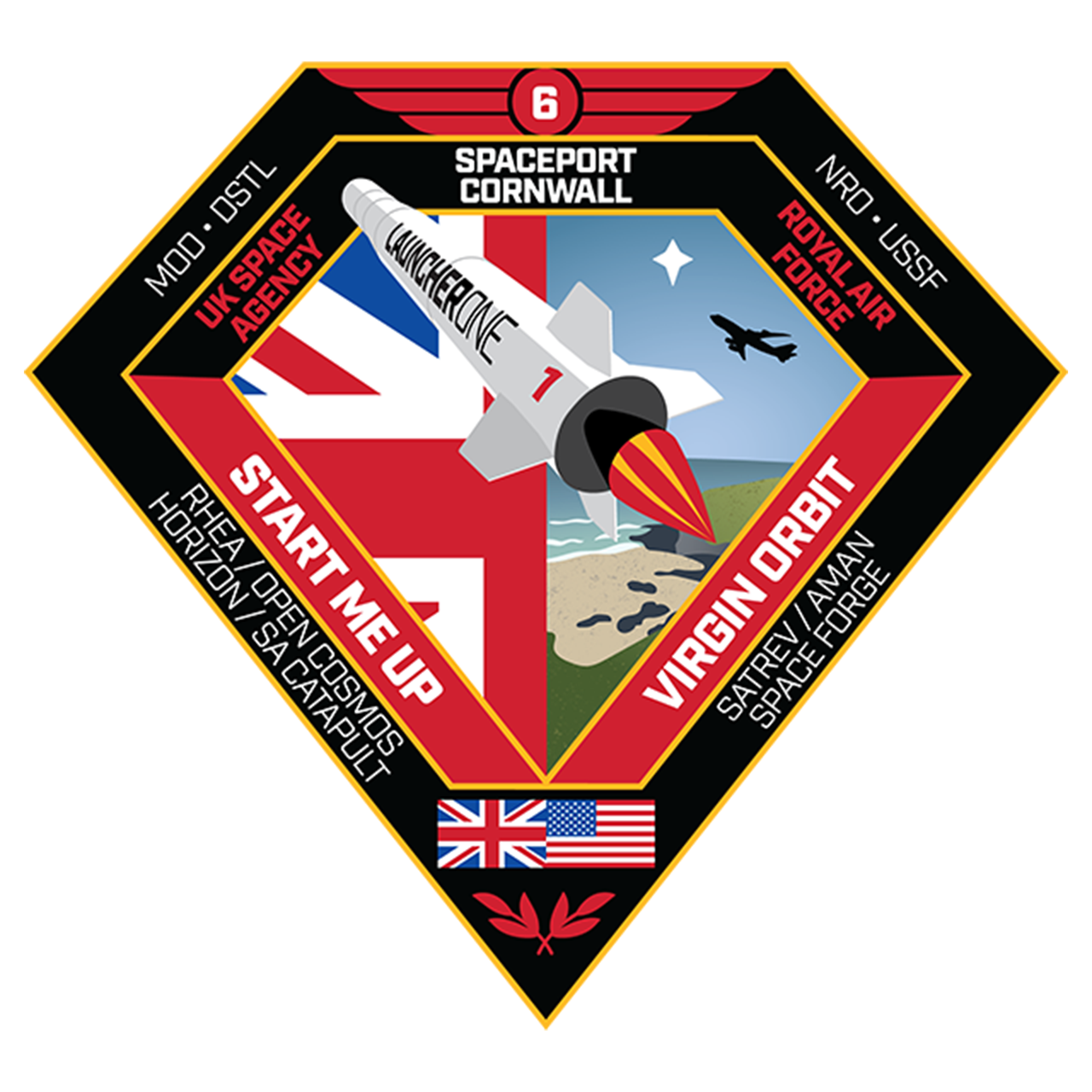
The satellites will ride to orbit inside a payload module at the front of the rocket. Work to integrate the satellites with this structure is already under way.
This coming weekend, the UK Space Agency will be displaying a 21m (70ft) life-size replica of the Virgin Orbit rocket outside the Science Museum in London.
The real rocket is expected to arrive in Cornwall from California in the next few days.
This inaugural launch has been made possible through cooperative agreements between the British and American governments.
Melissa Thorpe, the head of Spaceport Cornwall, watched the 747 come into Newquay.
"This is the moment we have been waiting eight years for and my team could not be more excited to welcome Cosmic Girl to the UK," she said.
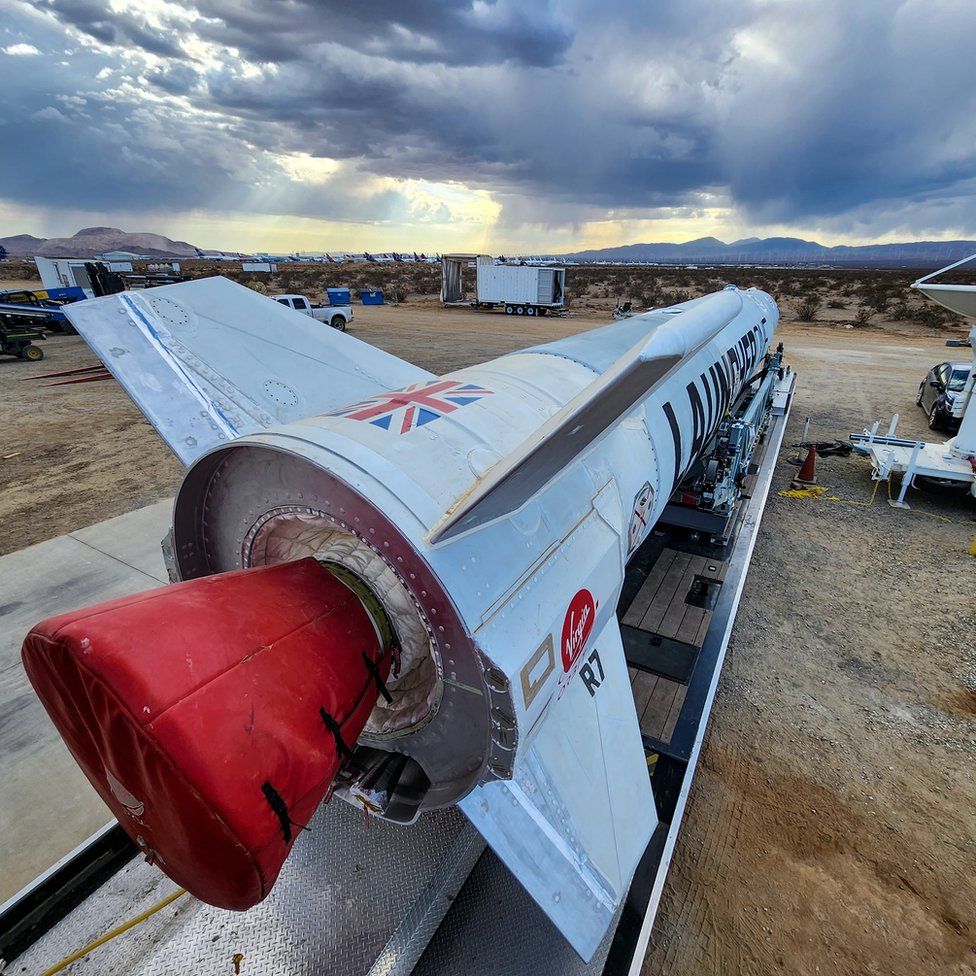
RAF C-17 Globemaster delivers Virgin Orbit's 'LauncherOne' rocket to Cornwall
Space Cornwall is preparing for the first-ever space launch from UK soil.
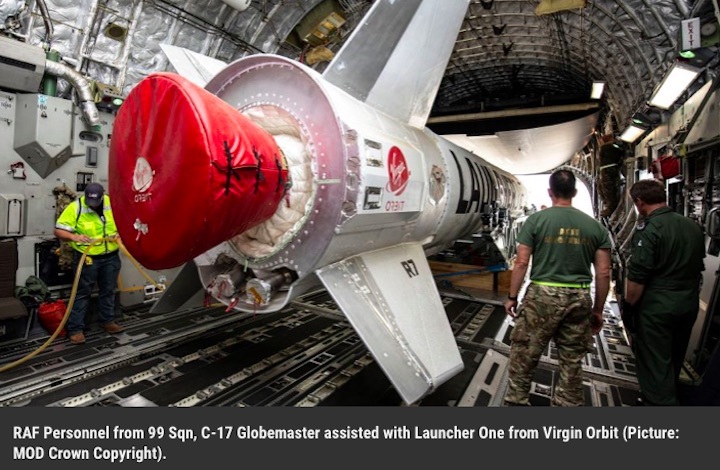
A Royal Air Force C-17 Globemaster has arrived at Space Cornwall carrying Virgin Orbit's 'LauncherOne' rocket.
The RAF and UK Space Command are supporting #StartMeUp – the first-ever space launch from the UK which is due to take place later this year.
In the cockpit of the launch will be Squadron Leader Mathew Stannard, an RAF test pilot working within Virgin Orbit.
Squadron Leader Matthew Stannard is on secondment from the RAF to Virgin Orbit – and used a modified 747 jet in July to successfully deliver a rocket to an altitude, of 500km above the earth's surface, before launching it.
Now all eyes are on the next mission planned to take off from Cornwall later in the year.
Sir Richard Branson's US company Virgin Orbit has successfully placed seven spacecraft in orbit from California and is now focusing on its operations in England following the move to Space Cornwall.
RAF's rocket man in January helped launch the Virgin Orbit space rocket over the Pacific.
The hope is that this UK-based launch will help the UK Armed Forces gain a technological edge while also inspiring a new generation of British space scientists.
Quelle: Forces Net
